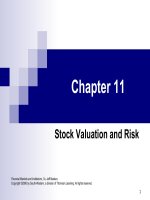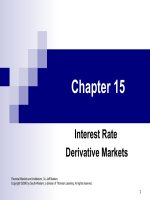Tài liệu Thị trường tài chính và các định chế tài chính_ Chapter 06 ppt
Bạn đang xem bản rút gọn của tài liệu. Xem và tải ngay bản đầy đủ của tài liệu tại đây (361.42 KB, 44 trang )
1
Chapter 6
Money Markets
Financial Markets and Institutions, 7e, Jeff Madura
Copyright ©2006 by South-Western, a division of Thomson Learning. All rights reserved.
2
Chapter Outline
Money market securities
Institutional use of money markets
Valuation of money market securities
Risk of money market securities
Interaction among money market yields
Globalization of money markets
3
Money Market Securities
Money market securities:
Have maturities within one year
Are issued by corporations and governments to
obtain short-term funds
Are commonly purchased by corporations and
government agencies that have funds available for a
short-term period
Provide liquidity to investors
4
Money Market Securities (cont’d)
Treasury bills:
Are issued by the U.S. Treasury
Are sold weekly through an auction
Have a par value of $1,000
Are attractive to investors because they are backed by
the federal government and are free of default risk
Are liquid
Can be sold in the secondary market through
government security dealers
5
Money Market Securities (cont’d)
Treasury bills (cont’d)
Investors in Treasury bills
Depository institutions because T-bills can be easily
liquidated
Other financial institutions in case cash outflows exceed
cash inflows
Individuals with substantial savings for liquidity purposes
Corporations to have easy access to funding for
unanticipated(dung truoc, huong truoc) expenses
6
Money Market Securities (cont’d)
Treasury bills (cont’d)
Pricing Treasury bills
The price is dependent on the investor’s required rate of
return:
Treasury bills do not pay interest
To price a T-bill with a maturity less than one year, the
annualized return can be reduced by the fraction of the
year in which funds would be invested
n
m
kP )1/(Par +=
7
Computing the Price of a
Treasury Bill
A one-year Treasury bill has a par value of
$10,000. Investors require a return of 8 percent
on the T-bill. What is the price investors would
be willing to pay for this T-bill?
259,9$
)08.1/(000,10$
)1/(Par
=
=
+=
n
m
kP
8
Money Market Securities (cont’d)
Treasury bills (cont’d)
Treasury bill auction
Investors submit bids on T-bill applications for the maturity of
their choice
Applications can be obtained from a Federal Reserve district
or branch bank
Financial institutions can submit their bids using the Treasury
Automated Auction Processing System (TAAPS-Link)
Institutions must set up an account with the Treasury
Payments to the Treasury are withdrawn electronically from the
account
Payments received from the Treasury are deposited into the
account
9
Money Market Securities (cont’d)
Treasury bills (cont’d)
Treasury bill auction (cont’d)
Weekly auctions include 13-week and 26-week T-bills
4-week T-bills are offered when the Treasury anticipates a
short-term cash deficiency
Cash management bills are also occasionally offered
Investors can submit competitive or noncompetitive bids
The bids of noncompetitive bidders are accepted
The highest competitive bids are accepted
Any bids below the cutoff are not accepted
Since 1998, the lowest competitive bid is the price applied to
all competitive and noncompetitive bids
10
Money Market Securities (cont’d)
Treasury bills (cont’d)
Estimating the yield
T-bills are sold at a discount from par value
The yield is influenced by the difference between the
selling price and the purchase price
If a newly-issued T-bill is purchased and held until
maturity, the yield is based on the difference between par
value and the purchase price
11
Money Market Securities (cont’d)
Treasury bills (cont’d)
Estimating the yield (cont’d)
The annualized yield is:
Estimating the T-bill discount
The discount represents the percent discount of the
purchase price from par value for newly-issued T-bills:
nPP
PPSP
Y
T
365
×
−
=
n
PP 360
Par
Par
discount bill-T ×
−
=
12
Computing the Yield of a
Treasury Bill
An investor purchases a 91-day T-bill for $9,782. If
the T-bill is held to maturity, what is the yield
the investor would earn?
%94.8
91
365
782,9
782,9000,10
365
=
×
−
=
×
−
=
nPP
PPSP
Y
T
13
Estimating the T-Bill Discount
Using the information from the previous example,
what is the T-bill discount?
%62.8
91
360
000,10
782,9000,10
360
Par
Par
discount bill-T
=
×
−
=
×
−
=
n
PP
14
Money Market Securities (cont’d)
Commercial paper:
Is a short-term debt instrument issued by well-known,
creditworthy firms
Is typically unsecured
Is issued to provide liquidity to finance a firm’s investment in
inventory and accounts receivable
Is an alternative to short-term bank loans
Has a minimum denomination of $100,000
Has a typical maturity between 20 and 270 days
Is issued by financial institutions such as finance companies and
bank holding companies
Has no active secondary market
Is typically not purchased directly by individual investors
15
Money Market Securities (cont’d)
Commercial paper (cont’d)
Ratings
The risk of default depends on the issuer’s financial condition
and cash flow
Commercial paper rating serves as an indicator of the
potential risk of default
Corporations can more easily place commercial paper that is
assigned a top-tier rating
Junk commercial paper is rated low or not rated at all
16
Money Market Securities (cont’d)
Commercial paper (cont’d)
Volume of commercial paper:
Has increased substantially over time
Is commonly reduced during recessionary periods
Placement
Some firms place commercial paper directly with investors
Most firms rely on commercial paper dealers to sell it
Some firms (such as finance companies) create in-house
departments to place commercial paper
17
Money Market Securities (cont’d)
Commercial paper (cont’d)
Backing commercial paper
Issuers typically maintain a backup line of credit
Allows the company the right to borrow a specified maximum
amount of funds over a specified period of time
Involves a fee in the form of a direct percentage or in the form
of required compensating balances
Estimating the yield
The yield on commercial paper is slightly higher than on a T-
bill
The nominal return is the difference between the price paid
and the par value
18
Estimating the Commercial
Paper Yield
An investor purchases 120-day commercial paper
with a par value of $300,000 for a price of
$289,000. What is the annualized commercial
paper yield?
%42.11
120
360
289,000
289,000- 300,000
=
×=
cp
Y
19
Money Market Securities (cont’d)
Commercial paper (cont’d)
The commercial paper yield curve:
Illustrates the yield offered on commercial paper at various
maturities
Is typically established for a maturity range from 0 to 90 days
Is important because it may influence the maturity that is
used by firms that issue CP
Is similar to the short-term range of the Treasury yield curve
Is affected by short-term interest rate expectations
Is similar to the yield curve on other money market
instruments
20
Money Market Securities (cont’d)
Negotiable certificates of deposit (NCDs):
Are issued by large commercial banks and other
depository institutions as a short-term source of funds
Have a minimum denomination of $100,000
Are often purchased by nonfinancial corporations
Are sometimes purchased by money market funds
Have a typical maturity between two weeks and one
year
Have a secondary market
21
Money Market Securities (cont’d)
Negotiable certificates of deposit (NCDs)
(cont’d)
Placement
Directly
Through a correspondent institution
Through securities dealers
Premium
NCDs offer a premium above the T-bill yield to compensate
for less liquidity and safety
Premiums are generally higher during recessionary periods
22
Money Market Securities (cont’d)
Negotiable certificates of deposit (NCDs)
(cont’d)
Yield
NCDs provide a return in the form of interest and the
difference between the price at which the NCD was
redeemed or sold and the purchase price
If investors purchase a NCD and hold it until maturity, their
annualized yield is the interest rate
23
Money Market Securities (cont’d)
Repurchase agreements
One party sells securities to another with an agreement to
repurchase them at a specified date and price
Essentially a loan backed by securities
A reverse repo refers to the purchase of securities by one party
from another with an agreement to sell them
Bank, S&Ls, and money market funds often participate in repos
Transactions amounts are usually for $10 million or more
Common maturities are from 1 day to 15 days and for one,
three, and six months
There is no secondary market for repos
24
Money Market Securities (cont’d)
Repurchase agreements (cont’d)
Placement
Repo transactions are negotiated through a
telecommunications network with dealers and repo brokers
When a borrowing firm can find a counterparty to a repo
transaction, it avoids the transaction fee
Some companies use in-house departments
Estimating the yield
The repo yield is determined by the difference between the
initial selling price and the repurchase price, annualized with
a 360-day year
25
Estimating the Repo Yield
An investor initially purchased securities at a price
of $9,913,314, with an agreement to sell them
back at a price of $10,000,000 at the end of a
90-day period. What is the repo rate?
%50.3
90
360
9,913,314
314,913,9000,000,10
360
rate Repo
=
×
−
=
×
−
=
nPP
PPSP









